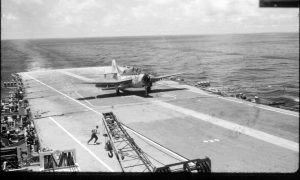- Author
- A.N. Other
- Subjects
- Naval Aviation, Ship histories and stories
- Tags
-
- RAN Ships
- HMAS Albatross (Shore Establishment), HMAS Melbourne II
- Publication
- December 2011 edition of the Naval Historical Review (all rights reserved)
By CMDR (P) R.V. Morritt, RAN Rtd
The Fairey Gannet A/S 1 aircraft was introduced into the Royal Australian Navy (RAN) Fleet Air Arm (FAA) in 1955. When embarked in the newly acquired HMAS Melbourne, Australia’s Naval Air Anti-Submarine power during the fifties and sixties was the most modern and technically advanced in the whole of South East Asia.
Not a ‘glamour’ aircraft by any stretch of the imagination, the Fairey Gannet was perhaps one of the most interesting at that time. Its unique engine arrangement, mission profile and capability, and large size and beautiful inverted gull wing still attract admiration and attention from aviation aficionados and enthusiasts alike. A twin turbo-propeller aircraft; it was fitted with an Armstrong-Siddeley Double Mamba turbine engine, driving the contra-rotating propellers via a central shaft and gear box, which in turn was lubricated by engine oil from a single oil supply tank. Herein lay one of the two stings in the tail of the Gannet upon which I shall enlarge a little later.

I seemed destined to set off a string of ‘firsts’ when, in 1953, having been selected for National Service Training, our course would be the first to undergo Flying Training, and I was selected in this first training group to be trained on Tiger Moths to Private Pilot License standard. Upon completion of NST I decided to join the RAN Fleet Air Arm and continue training to Wings standard. Upon graduation, I was awarded the Weapons trophy and the Goble Trophy for the Most Proficient Pilot on course. Having been trained in the Tiger Moth, followed by Wirraway, Firefly Mk V1 and Sea Fury FB11 aircraft, the shock and awe upon being confronted by the increasing size and complexity of each succeeding model was difficult to overcome. However, the sheer bulk of the Gannet was something to behold when standing next to it trying to work out how to gain entry to the cockpit!
It had a crew of three, pilot in front of course, Observer (Navigator/Tactical operator) in the center cockpit, and Radio Operator in the rear cockpit – facing rearwards. The fuselage was a huge, slab-sided affair with the cockpit some ten feet above the ground. Entry was by means of a three-step ladder, which was lowered and raised by hand, followed by a series of indented foot/handholds ascending in a large diamond pattern. When commencing training on this aircraft the very first lesson was to establish which foot to place in the lowest step in order to ascend successfully into the required cockpit! Start with the wrong foot and one could easily find oneself led into the wrong cockpit. One could only undo this error by descending and re-commencing with the correct foot!
I was very fortunate in that my Flight Instructor, Lieut. Herbie Becker, was an excellent instructor who knew the aircraft inside out and was able to pass this knowledge on to me. I am sure that had it not been for him I would almost certainly not have had the in-depth understanding of the Flight Fine Pitch Stop system in the Gannet which stood me in such good stead later; knowledge which went a long way towards saving my life and those of my crew.
When embarked, the Gannet aircraft routinely averaged sortie times of around 3-4 hours. Anti-Submarine equipment was not much more than the MK1 Eyeball! A basic radar (ASV19B), a mix of mainly non-directional and a small number of directional sonobuoys, and a small number of hand launched smoke markers completed the A/S detection kit. It was also possible to carry two homing torpedoes, a few depth charges or a small number of 250 lb. bombs either in the bomb bay or on wing racks, and occasionally 60lb rockets. That completed the ASW capability.
Engine failures
Standard operating procedure called for normal cruise configuration to be on single engine in order to conserve fuel. Anti-submarine search operations were routinely below 1500 feet in all weather, day and night. The single-engine cruise protocols called for the operating engine to be swapped hourly in order to even out the running hours. Operations were normal for the first year or two utilizing the above-mentioned protocols. However, it was not long before aircraft began suffering engine failures at a disturbing frequency, almost always preceded by a rapid loss in oil pressure. This resulted in an increase in single engine deck landings, something to which pilots did not look forward, particularly in heavy seas and/or bad weather. Eventually Fairey Aviation discovered that the prolonged single engine cruising was causing ‘Brinelling’, or pitting, of the propeller bearings in the feathered propeller. This in turn was causing metal particles to be distributed through the oil into both engines and propellers due to the single oil supply tank … the first of the two stings in the Gannet tail!




